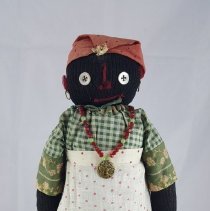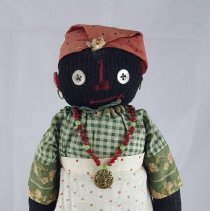Object Record
Images


Metadata
Object Name |
Doll |
Catalog Number |
1967.004.25 |
Description |
"Aunt Jemima", homemade black stocking rag doll. Doll has cotton filling, white button eyes, red yarn ears, nose, and mouth. She is wearing a red faded bandanna with black dots and three leaf clovers with a white ball with a small gold bead above her nose on the bandanna. She has a green and white gingham dress with a green floral hem and sleeves. She is wearing a white apron with red polka dots. The dress is cinched together at the neck and has two green beads dangling on the strings. She has gold hoop earrings sewn onto both ears and is wearing a red and green beaded necklace with a metal floral pendant in the center that sits on her apron. |
Provenance |
This doll was refered to as an "Aunt Jemima Doll" by the donor. |
Date |
c. 1920 |
Material |
Sock |
Dimensions |
H-16 inches |
Height (in) |
16.000 |
Subjects |
"Things that Matter" Sports & Leisure |
Notes |
Featured in Things that Matter "Alice Frazee Ginn was born in La Crosse in 1914. Her father, Oren Frazee, was the head of the biology department of La Crosse State College, now known as the University of Wisconsin-La Crosse. An only child of doting parents, Alice saved many family heirlooms, which she donated to the La Crosse County Historical Society. Her childhood dolls were part of the donation, accompanied by a handwritten list with their names and descriptions. She had baby dolls — "pretty lady" dolls — and this homemade mammy doll she called Aunt Jemima. Aunt Jemima’s body is made of black knit wool, possibly from socks, which is stuffed and dressed in a cotton print dress, apron and head kerchief. She has gold-hoop earrings and a bead necklace. Eyes are sewn-on buttons, while nose and mouth are embroidered with red yarn. More than likely this doll was made from a purchased pattern or one printed in a women’s magazine. Alice and her parents were white, not African American, and her mammy doll is a common and typical artifact of the Jim Crow era, roughly 1877 to 1960. That’s when Black Americans were intentionally disenfranchised by laws and customs, while at the same time culturally defined and demeaned by a series of stereotypes commonly seen in advertising, publications and entertainment. A remarkable number of household products were sold with promotional images of black servants touting them, and a few still remain on store shelves today — Uncle Ben’s rice and Aunt Jemima pancake mix are two of the best known — and Aunt Jemima is a classic example of the mammy stereotype that was seen as the nurturing, nonthreatening and devoted family servant. The character played by Hattie McDaniel in the 1939 film "Gone with the Wind" is another example. Figures such as Alice’s doll are recognizable as mammys by their rotund bodies, head scarves and earrings, as well as their skin color. Today items like this are prized by collectors. Mammys were popular themes for cookie jars, broom dolls, clothespin bags and all sorts of small household items. The unavoidable association with devoted servitude was apparently reassuring to mainstream white culture. Alice’s Aunt Jemima doll was included in her donation to the historical society in 1967. It shows some signs of wear, but its condition is remarkably good. I have no idea how Alice, who died in 1989, felt about African Americans or the Civil Rights Movement, but it makes me sad to think how this doll was actually part of a broader cultural pattern of racism. Evidence of attitudes toward different ethnic or cultural groups are important to preserve in an historical artifact collection so that we can examine and learn from the past and not just view it through the rosy lens of nostalgia. When the evidence is as charming as this little doll, the truth can be hard to acknowledge." This article was originally published in the La Crosse Tribune. Title: Alice Ginn's Doll Author: Peggy Derrick Publish Date: April 29, 2017 "In 1890, a former slave named Nancy Green was hired to be the spokesperson for Aunt Jemima brand food products. Nancy Green was born into slavery in 1834 in Montgomery County, Kentucky. In 1889 the creators of Aunt Jemima, Charles Rutt and Charles Underwood, sold the company to R.T Davis, who soon found Nancy Green in Chicago. The previous owners had already agreed upon her ‘look’ of a bandana and apron. Davis combined the Aunt Jemima look with a catchy tune from the Vaudeville circuit to make the Aunt Jemima brand. Green’s identity was first uncovered at the Worlds’ Columbian Exposition in 1893. There were so many people interested in the Aunt Jemima exhibit, police were called for crowd control. Green served pancakes to thousands of people. People loved her warm personality and friendly demeanor, not to mention her cooking. Green was given an award for showmanship at the exposition. As a result of her dedication, Aunt Jemima received 50,000 orders for pancake mix. Not only did flour sales soar, but Green received a lifetime contract to serve as spokesperson. She was a living legend of the brand until she died in a car accident in September 1923." Information from: Black America Web Website: https://blackamericaweb.com/2013/03/28/little-known-black-history-fact-the-history-of-aunt-jemima/ Article Title: Little Known Black History Fact: The History of Aunt Jemima Author: Erica Taylor Accessed 06/29/2017 |